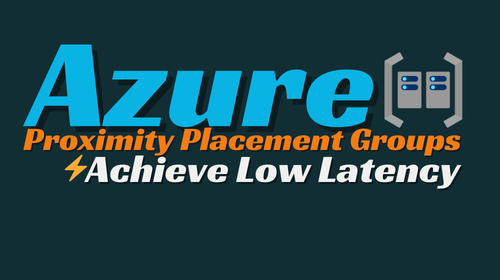- Home
- Cloud Architecture Design
- How Azure Proximity Placement Groups Help to Achieve Low Latency
How Azure Proximity Placement Groups Help to Achieve Low Latency
How Azure Proximity Placement Groups Help Customers Achieve Low Latency for Their Cloud Apps
In today’s digital age, the speed and performance of cloud applications are crucial. Users expect seamless experiences, and any lag can lead to frustration, loss of productivity, or even revenue. One of the most critical factors influencing the performance of cloud applications is latency—the delay before a transfer of data begins following an instruction. To mitigate latency issues and enhance the user experience, Microsoft Azure offers a powerful feature known as Proximity Placement Groups (PPGs).
In this blog, we’ll explore what Azure Proximity Placement Groups are, how they work, and how they can help you achieve low latency for your cloud applications.

Understanding Latency in Cloud Environments
Before diving into Proximity Placement Groups, it’s essential to understand latency and its impact on cloud applications. Latency refers to the time it takes for data to travel from one point to another in a network. In cloud computing, latency can affect everything from the responsiveness of applications to the speed of data processing.
Several factors can contribute to latency, including the physical distance between the cloud resources and users, network congestion, and the placement of virtual machines (VMs) within a data center. High latency can lead to slower application performance, which can be particularly problematic for applications requiring real-time processing, such as online gaming, financial transactions, or video streaming.
What Are Azure Proximity Placement Groups?
Azure Proximity Placement Groups are a feature designed to reduce the latency between VMs by placing them in close physical proximity within an Azure region. Essentially, PPGs ensure that your VMs are located on the same or nearby physical hardware, thereby reducing the distance data needs to travel and minimizing latency.
When you create a Proximity Placement Group, Azure intelligently places the VMs associated with that group as close to each other as possible. This proximity minimizes the latency caused by inter-VM communication, which is particularly beneficial for workloads that are sensitive to latency, such as distributed databases, high-performance computing (HPC) applications, and large-scale simulations.
How Proximity Placement Groups Work
Here’s how Proximity Placement Groups operate in a typical Azure deployment:
VM Placement: When you deploy VMs into a Proximity Placement Group, Azure’s infrastructure ensures that these VMs are placed close together within the same data center or nearby data centers. This proximity is measured in terms of network hops—the fewer the hops, the lower the latency.
Optimized Networking: Azure uses advanced networking technologies to further reduce latency between VMs in a PPG. This includes low-latency networking hardware and optimized routing algorithms.
Predictable Performance: By ensuring that your VMs are close to each other, PPGs provide more predictable and consistent performance, especially for applications where inter-VM communication is frequent and latency-sensitive.
Benefits of Using Proximity Placement Groups
Reduced Latency: The most significant benefit of PPGs is the reduction in latency. By keeping VMs physically close, the time it takes for data to travel between them is minimized, resulting in faster application performance.
Improved Application Performance: For applications that rely on quick data exchanges between multiple VMs, such as distributed databases or clustered applications, PPGs can lead to significant performance improvements.
Enhanced User Experience: Lower latency translates to a better user experience, especially for end-users who require real-time interactions with your applications.
Flexibility and Control: PPGs give you greater control over the placement of your VMs within an Azure region, allowing you to optimize the deployment of latency-sensitive workloads.
Use Cases for Proximity Placement Groups
High-Performance Computing (HPC): HPC applications often involve large-scale simulations or data processing tasks that require low-latency communication between nodes. PPGs ensure that these nodes are as close as possible, reducing latency and speeding up computations.
Distributed Databases: In distributed database systems, nodes frequently exchange data. PPGs help reduce the latency of these exchanges, improving the overall performance of the database.
Financial Services: Applications in the financial sector often require real-time data processing and low-latency transactions. PPGs help ensure that these applications run smoothly and efficiently.
Online Gaming: Multiplayer online games require real-time communication between servers to provide a seamless gaming experience. PPGs reduce latency between game servers, resulting in a more responsive and enjoyable experience for players.
Ensuring low latency is crucial for delivering high-performance cloud applications. Azure Proximity Placement Groups offer a simple yet powerful solution to reduce latency by optimizing the physical placement of your VMs. Whether you’re running a distributed database, a high-performance computing application, or an online game, PPGs can help you achieve the low-latency performance your users demand.

